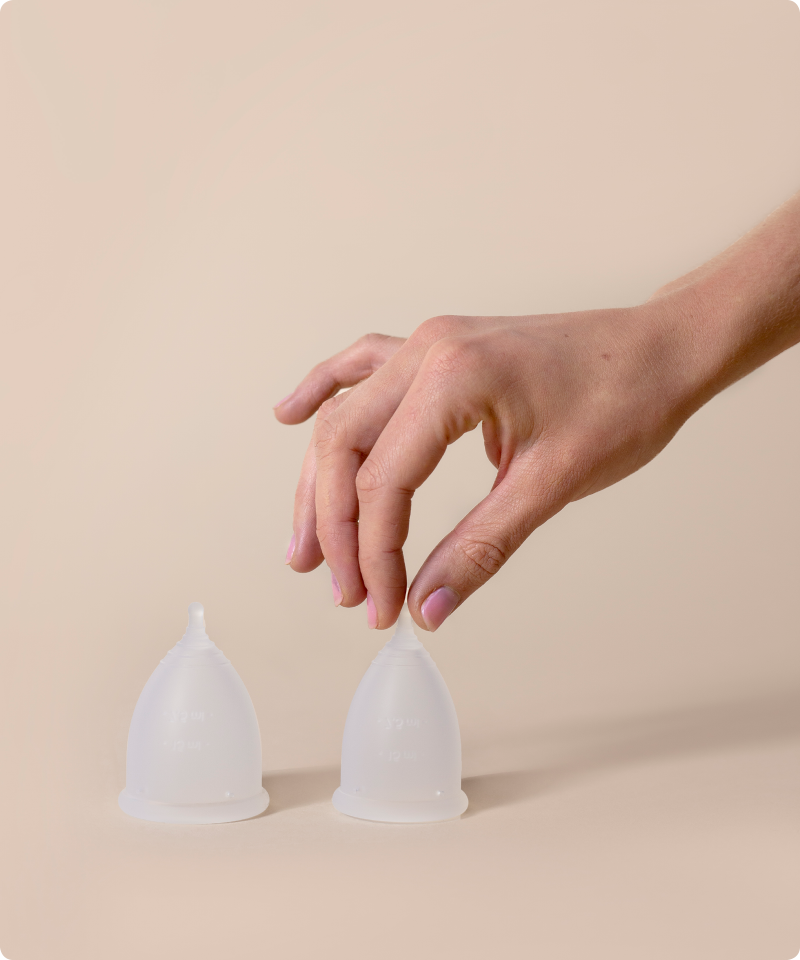Abnormal Pap test result? No panic! Cycle tells you what to expect.
It’s very common for an abnormal smear to turn out to be a false alarm. And even if precancerous cells are detected, the chance of actual cancer is small. Precisely because such an early stage is easily treatable.
Every woman in the Netherlands between the ages thirty and sixty is confronted with it once every 5 years: the population screening for the Pap test. With a simple self-test at home or with a speculum and brush at the doctor’s, a sample of cells are taken from the cervix. This sample is first tested for the presence of HPV (Human papillomavirus). There are many types of HPV. Most types are not dangerous, but a few types can cause (precancerous conditions for) cervical cancer. HPV types 16 and 18 are the most dangerous and are considered a high-risk HPV (hr-HPV). When this high-risk HPV is found, your sample is then tested for abnormal cells. If you have a positive home test, you have to take a Pap test at the doctor’s office. The results are expressed in Pap 0 to Pap 5. If you would like to see an overview of all the possible Pap results, read this article, which briefly breaks down everything. For accurate results it’s recommended to not take a pap test:
during your menstrual period
during a pregnancy
during breastfeeding
Pap-result 1 or 2: No treatment necessary
Pap 1 means that the smear is good. The cells are normal and you can return in 5 years for the next screening. Pap 2, 3a, 3b, 4, and 5 Indicate an abnormality - a fraction of the cells in the cervix are not as usual. The lower the number, the smaller the chance of a (tissue) abnormality. If you have a Pap 2 result and you are HPV positive, then the doctor will refer you to a gynecologist for a colposcopy (using a magnifying glass to look at the color of your cervix). However, treatment is rarely necessary, because there are only very slight tissue abnormalities (CIN1), which your body handles itself through your immune system. In such cases, the gynecologist usually advises you to come back after a year for another check-up.
Colposcopy
A colposcopy is always performed after the first HPV positive or Pap 2 results. The gynecologist inserts a speculum and applies a special substance (3% diluted acetic acid) to the cervix. The substance turns abnormal cells white, with some stray abnormal blood vessels occasionally, allowing the gynecologist to assess the need for a biopsy: a small sample of tissue from the cervix. If the doctor doesn’t see anything unusual you can come back after a year for another check-up. In other cases, a biopsy is taken immediately after a local anesthetic. The taken tissue sample is then further examined under the microscope. The results are called the CIN results. CIN is an abbreviation of Cervical Intraepithelial Neoplasia.
Want to read more about colposcopy? You can find more information here.
What are CIN-results?
The tissue sample taken from the biopsy is examined under a microscope. The cells are not only checked for abnormalities, but also on how they relate to each other and behave in your body. The Pap test is less suitable for this. When the cells show irregular behavior, the term dysplasia is also used sometimes. The CIN results are important to determine further treatment.
CIN 1: A slight abnormality. In most cases, the body resolves the problem on its own by clearing the abnormal cells. Usually, no treatments are given. The gynecologist will perform another check-up at your GP after a year.
CIN 2: A moderate abnormality. Sometimes, treatment is necessary, but the abnormal cells can still disappear on their own. There are two possibilities: Either you wait an additional 6 months and perform another Pap test or you receive treatment. Both your age and whether you want to have children are taken into account for this decision. In many cases, the treatment is a so-called LEEP (Loop Electrosurgical Excision Procedure) and there are small risks associated with this procedure, such as a higher risk of premature birth. Some women prefer to have the abnormal cells removed despite this risk, while others prefer to wait and see. One is certainly not better than the other and the choice is personal!
CIN 3: A severe abnormality, however, not malignant. Treatment is recommended as the chance that the abnormality will disappear on its own is very small. If your Pap test has a Pap result of 4 or 5 and the gynecologist already sees strong signs of a CIN3-abnormality during the colposcopy, biopsy can be skipped and the decision to proceed with treatment can be made immediately. In Pap 4, a LEEP is performed in 90% of the cases.
Treatment: Loop Electrosurgical Excision Procedure (LEEP)
With a LEEP a small piece of tissue is taken from the cervix, peeled off to be precise. This is where the abnormal cells are located. A LEEP is a bit more invasive than a biopsy and will therefore always be performed under local anesthesia in the cervix. To remove the tissue, the gynecologist uses a thin metal wire in the shape of a loop. This “loop” is heated electrically and the tissue is cut away. It sounds painful, but - after the anesthesia of course - you won’t actually feel anything. It may smell a bit (reminiscent of a BBQ smell…) and you can usually see a small amount of smoke. But if you don’t know about this, the experience may be uncomfortable. To avoid feeling like you are set on fire during the procedure (which you really aren’t!), discuss what is going to happen exactly with your gynecologist beforehand. The procedure takes place in an outpatient clinic and you can go home immediately afterwards.
Recovery
It’s recommended to take it easy for a few days when you are at home. Because the lysis has created a small wound in the cervix, you may experience bloody discharge for a while. It’s important to use sanitary pads for the blood instead of tampons! It’s also not recommended to have sex, to swim, or bathe as long as you are still having bloody discharge to lessen the risk of inflammation and reopening the wound.
Risks
As with most procedures, there are risks involved. Because the cervix is shortened by a few millimeters, the risk of preterm birth can slightly increase in some cases. We’re not talking about major percentages, but if women are young and want to have children, the gynecologist is always cautious with this procedure. At times, a biopsy can trigger a kind of inflammatory reaction in the body, as a result your body starts to clear the abnormal cells on its own. In such cases, the results from your smear can be good again during your check-up six months later. Sometimes, the gynecologist gives their recommendation and other times the choice is up to you. Both options (treatment or non-treatment) carry their own set of risks - the question is which option weighs heavier to you. Your own wishes and feelings are very important!
Treatment: Cervical conization
If your CIN results are very abnormal, the abnormal cells are placed further inside the cervix, or the restless cells keep coming back, then the doctor may proceed with a conization. This procedure is somewhat similar to a LEED, but it’s more extensive and therefore more invasive. During a conization, the gynecologist samples a cone-shaped piece of tissue from the cervix with a scalpel. In general, this procedure is performed under general anesthesia or with an epidural. Because of this, you can’t eat before the procedure. The procedure takes place in the OR and you'll probably be able to go home the same day. Please take note that you’ll not be able to drive home yourself. Therefore, it’s nice if someone accompanies you - but it’s nice to have someone with you anyways!
Recovery
The recovery is more or less the same as with a LEED procedure. It’s recommended that you don’t do any activities and take it easy for a couple of days. Bleeding may last for one to several weeks. Use sanitary pads to absorb the blood instead of tampons! And the rules apply here as well: don’t have sex, go swimming, or take a bath as long as you’re still losing blood.
Risks
The chances of preterm birth may increase after the procedure, because of this, the doctor will only perform a conization if they deem it absolutely necessary. Scarring tissue might also form in the cervix as a result, preventing menstrual blood from flowing properly. This can cause you to have less blood loss and more abdominal pain than usual during periods.
And what happens afterwards?
Certainly, the doctor will discuss all the results with you as soon as they are known. Depending on the results of the colposcopy and any tissue taken, a smear test will be repeated after 6 or 12 months. If the test results of the check-up are good, then you don’t have to return to the gynecologist and you’ll have your next Pap test during the regular population screening at your GP.
Cervical Cancer
It’s good to realize that precancerous cells do not automatically mean you’ll develop cervical cancer if you choose to withhold treatment. Most women with CIN3 will probably never develop cervical cancer, even if they are not treated. Due to the regular Pap screening, you’re (almost) always on time, and therefore, the percentage of deaths from cervical cancer are very low. Only three in 100,000 women pass away from cervical cancer, that is 0.003%. But at the same time, the chance that it does develop into cervical cancer still remains an actual risk. That is precisely why the population screening is carried out regularly, in order to prevent this from happening.
Is it mandatory to participate in the population screening?
No, it’s not mandatory, but we strongly advise you to take the test anyway. If you’re diagnosed in the early stages, abnormalities can be properly treated thereby lessening the severity of the consequences. It always starts with an HPV infection. If this isn't treated properly by your body, abnormal cells can develop into precancerous cells. If this is ignored, they can further develop into cervical cancer. This article explains this process in a couple of sentences, but in reality, it can take about ten to fifteen years for a permanent infection to actually grow into cancer. This is why there is no reason for panic when you receive an abnormal Pap test result. Rather, be reassured! You'll be properly monitored and can be quickly treated if necessary. So as far as we’re concerned, shrug off the idea of that speculum and skip your way to the doctor’s office.
‘75% of women between their thirties and sixties receive a test result which indicates the presence of abnormal cells’
Why do women start taking the Pap test after their thirties? You’ll hear this question every now and then. And yes, it’s true that you can be infected with the HPV-virus before your thirties, but the chance is really big that the carrier has only recently contracted the virus. On top of this, young people often have a stronger immune system, so, in most cases, the body can take care of the virus on its own. It would be a shame to treat young women (with all the risks the procedures can bring) without it actually being necessary. Although, exceptions do exist. Would you like to read more about which symptoms require a visit to your GP? Then you can check this article.
Are you reluctant to take the Pap test at your doctor’s and is this why you don’t want to participate? You should know that it’s also possible to request a self-test after you received your invitation for the population screening. You can take the test in the safety of your own familiar environment and send the sample back to the laboratory. Great to know that this is a possibility as well, right?
Cervical cancer is most common in women who don’t participate in population screening and therefore don’t get checked regularly and/or on time. You’re free to choose whether to take the test or not, but we thought we should mention this…Oh and yes, taking the Pap test through the population screening is completely free! Any follow-up examinations will go through your health insurance, however.
Vaccinating against HPV
Something else about HPV. This virus is sexually transmitted and once you’re sexually active, almost everyone experiences an HPV infection once in their life. You won’t notice anything, though, because there are no other symptoms. Getting vaccinated against HPV can prevent an abnormal Pap result, however, there is no guarantee that a vaccination will prevent anything 100%. Would you like to read more about this? You can do so here.


























